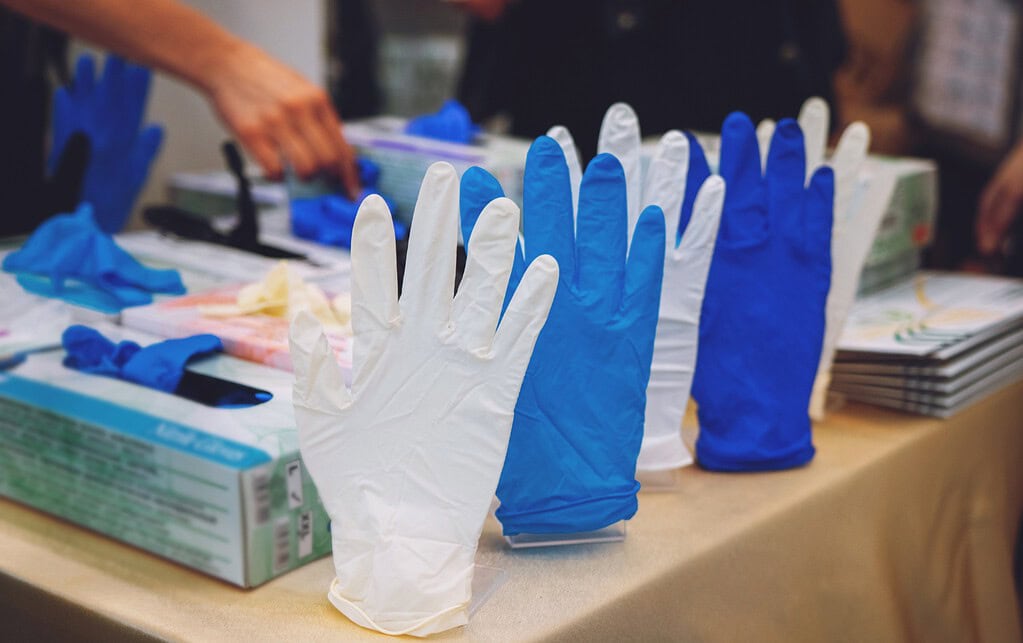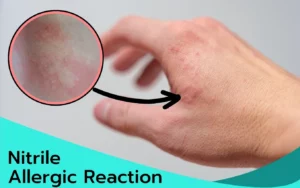Disposable nitrile gloves come in a variety of colors, each serving specific purposes in different industries. Colors are important for identifying materials, preventing contamination, and ensuring safety.
Table of Contents
Common Colors and Their Reasons

Blue Nitrile Gloves
Blue nitrile gloves are commonly used in healthcare because they make it easy to spot any damage, which is important for keeping things clean and preventing infections. Any tears or punctures are easily spotted due to the contrast against the skin. Additionally, their differentiation from latex gloves helps avoid allergic reactions.
White Nitrile Gloves
White nitrile gloves, commonly used in cleanroom environments, are necessary for maintaining cleanliness and preventing cross-contamination. Their visibility of contaminants and use as a base layer in double-gloving practices ensure utmost hygiene standards in healthcare settings.
The choice of white nitrile gloves in healthcare and laboratory environments is strategic. These gloves not only look clean and clinical but also make it easy to see contamination or dirt, helping to maintain high hygiene standards. Additionally, their use as a base layer in double-gloving practices ensures that any breaches are quickly detected, enhancing safety measures in medical procedures.
Benefits of Using Colored Gloves
Identification and Differentiation
Colored gloves like blue, white, purple, and more serve important identification purposes in medical settings. Blue gloves are commonly used to differentiate nitrile gloves from latex ones, crucial for avoiding allergic reactions. White gloves, on the other hand, are often used in cleanroom environments due to their high visibility and ability to spot contaminants easily.
Enhanced Safety and Hygiene
To maintain safety and hygiene standards, colored gloves play a significant role. Light-colored gloves like white help in detecting contaminants and hazardous materials efficiently, reducing the risk of cross-contamination. Additionally, colored gloves, especially blue, offer a sharp contrast against the skin, aiding in the quick detection of defects like punctures or tears.
Benefits
To enhance patient comfort and perception, healthcare professionals may choose specific colored gloves to create a calming and welcoming environment. For example, using blue or purple gloves can help put patients at ease during medical procedures, ultimately contributing to a positive patient experience.
Safety
To ensure durability and practicality in medical applications, colored gloves like blue nitrile gloves are favored for their resistance to chemicals and high tactile sensitivity. This durability makes them suitable for a wide range of tasks where precision and safety are paramount.
Practicality
Overall, the different colors of disposable nitrile gloves serve practical purposes in various industries, from improving safety and hygiene to enhancing patient comfort and perception. Each color choice is deliberate, offering specific benefits that contribute to efficient and effective workflow in medical settings.
Color Coding for Safety
Any safety-conscious individual understands the importance of color coding in maintaining a secure environment. Different colors of disposable nitrile gloves serve as visual cues, aiding in material identification and safety protocols. For instance, purple gloves can designate higher allergen protection, while orange gloves provide high visibility in fast-paced environments like emergency medical services.
The color-coded system of disposable nitrile gloves not only offers practical benefits but also enhances safety measures. By quickly differentiating between glove types based on color, healthcare professionals can streamline processes and minimize the risk of cross-contamination. This color-coded approach is a simple yet effective way to uphold safety standards in various industries.
Industry-Specific Colors
1. Blue
- Why Used?: Blue is the standard color for disposable nitrile gloves.
- Benefits: Easy to spot tears or punctures against the background of most skin tones and surfaces.
Industries: Medical, dental, food processing.
2. Black
- Why Used?: Provides a sleek, professional look.
- Benefits: Helps mask stains from ink, oil, or other substances. Offers a clean appearance.
Industries: Tattoo parlors, automotive, law enforcement.
3. Purple
- Why Used?: Distinguishes itself from standard blue.
- Benefits: Often used to differentiate between different glove requirements or tasks.
Industries: Healthcare, particularly in settings requiring higher allergen protection.
4. White
- Why Used?: Common for applications requiring high cleanliness.
- Benefits: Highlights contamination or dirt easily.
Industries: Health care, laboratory, clean rooms.
5. Green
- Why Used?: Indicates chemical resistance.
- Benefits: Often used in labs to signify usage in handling chemicals.
Industries: Chemical handling, veterinary, environmental services.
6. Orange
- Why Used?: High visibility.
- Benefits: Ideal for situations where high visibility and safety are critical.
Industries: Construction, automotive, emergency medical services.
Color, Industry Use, and Primary Benefit
Your nitrile disposable gloves come in various colors, each offering specific benefits based on the industry they are used in and their primary purpose. In the table below, you’ll find a breakdown of common glove colors, the industries they are most commonly used in, and their primary benefits. Each color serves a unique function, from easy tear detection to high visibility for safety.
| Color | Industry Use | Primary Benefit |
|---|---|---|
| Blue | Medical, Dental, Food | Easy to spot tears, punctures |
| Black | Tattoo, Automotive, Law | Masks stains, clean appearance |
| Purple | Healthcare | Allergan protection, glove differentiation |
| White | Health care, Labs | Highlights contamination, cleanliness |
| Green | Chemical, Environmental | Signifies chemical usage |
| Orange | Construction, Emergency | High visibility, safety |
Following this exploration of the colors of nitrile disposable gloves, it is evident that each hue serves a specific purpose in various industries, from medical settings to automotive workshops. These colors, like the vibrant plumage of birds in the wild, are not just for show. They play necessary roles in enhancing safety, hygiene, professional appearance, and task differentiation. Just as nature’s palette is diverse and purposeful, so too are the colors of nitrile gloves in their practical applications.






